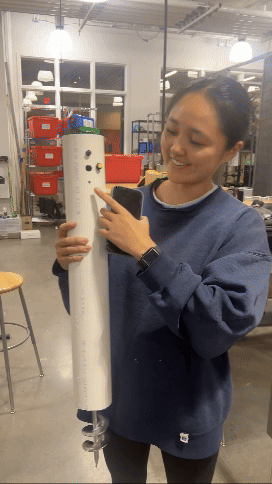
The Root
Self Burrowing Sand Spike
Fall 2024
Student Project
Team Memebers
Minha Kim, Joao Carvalho, Aryan Kothari
Skills
CAD, Fabrication
Project Overview
At the beginning of the fall of 2024, the team was tasked with creating a product that aligned with the theme “Sand, Sea, and Sun." After extensive brainstorming sessions, we conceptualized and designed The Root. This product is a self-burrowing spike that securely anchors into the sand and features table and speaker attachments.
Paint Point:
Keeping belongings out of sand while at the beach
Design Considerations:
Stability, portability, waterproof, sand resistant mechanisms
Self Burrowing sand spike with table and speaker attachments
Solution:
Automated Drilling
Effortlessly drill into sand with a motorized spike system that saves time and eliminates manual effort. Perfect for securely anchoring beach accessories in seconds.
Locking Mechanism
Easily attach and secure beach accessories such as umbrellas, tables, or speakers using our versatile mounting connector. Designed for a seamless beach experience.
App Controlled LEDs
Control LED lighting modes via a mobile app for different occasions: Party, Relax, UV Index, or Off. Set the mood or display critical beach information with a tap.
Ideation
Brainstorming + Design
The path to creating this product was incredibly circuitous. It began with a group brainstorming session in which we used a SPRINT method to come up with and vote on ideas. The sand spike was selected, and the team began to explore various form ideas. We filled up a LOT of whiteboards.
As the concept progressed throughout the project, the shape changed from a cylinder that burrowed into the sand along with the spike to a rectangular box that sat on top of the sand. After each prototype, the team gathered around a whiteboard and laid out what we liked and what we planned to change moving forward.
Prototype
To get an idea of the shape and scale, I used a paper towel roll, a DC motor, and some other parts lying around the shop to create a concept model of the Root. The speed of the “spike” was controlled by a potentiometer and powered using a 9V battery.
The first prototype was built to scale and incorporated additional electronic components, including a light sensor near the top of the device to ensure the spike stopped digging once it reached the proper depth.
The second prototype began to resemble our final design. Acrylic panels were mounted to L-brackets which also supported a large lithium-ion battery, a waterproof box of electronics, and a high-torque motor.
Concept
First Prototype
Second Prototype
Build
I created a 30+ piece CAD assembly of the Root. The sketches of the panels were exported to an Adobe Illustrator file and used to laser cut the panels, ensuring a perfect fit. The motor mount, battery holder, electronics holder, top piece, and difuser were 3D printed.
CAD
Fabrication
Mechanical Parts
The motor mount, electronics holder, battery holder, and top were printed on a Bambu printer at 80% infill.
Threaded inserts were heat sunk into the top piece and L brackets were used to attach the top to the aluminum 8020.
The wooden panels were laser cut and painted before they were mounted to the 8020.
The clear light diffusers were printed on a Bambu printer with 5% infill.
Electronics
10V DC motor was attached to the gearbox of a drill to provide the torque necessary to screw into the sand.
ESP32 microcontroller was used to connect the mobile app to Bluetooth.
Motor controller was used to regulate the speed of the screw.
LED matrix















